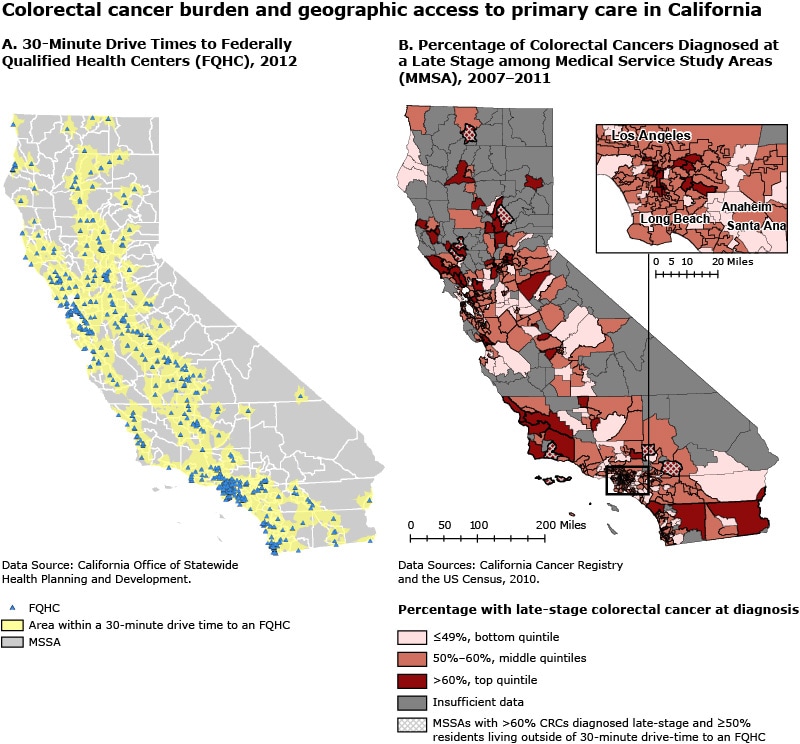
Colorectal Cancer Burden and Access to Federally Qualified Health Centers in California
GIS SNAPSHOT — Volume 12 — October 8, 2015
PEER REVIEWED
The figure consists of 2 maps of California. The first map (Map A) displays the locations of the 682 federally qualified health centers (FQHCs) and FQHC look-alikes (which serve the same population as FQHCs but do not receive the same grant funding) that were active in California in 2012. Around those locations, there is a drive-time buffer representing the area from which somebody could drive to at least 1 of the FQHCs within 30 minutes. The second map (Map B) displays the 542 Medical Service Study Areas (MSSAs). These are areas that are aggregations of census block groups and tracts and make up “rational service areas” for primary health care in California. MSSAs are displayed in 5 different categories based on the percentage of late-stage colorectal cancer (CRC) diagnoses and the percentage of the population in each category within the 30-minute drive-time area from the first map. The first category shows the bottom quintile MSSAs with regard to their percentage of late-stage CRC diagnoses (≤49%) with 93% of the residents of those areas being within the 30-minute drive time. The second category includes MSSAs in the middle 3 quintiles of percentage of late-stage CRC diagnoses (50%-60%) with 97% of the population within the 30-minute drive-time. The third category includes MSSAs in the top quintile of percentage of late-stage CRC diagnoses (>60%) with 96% of the population within the 30-minute drive-time. The fourth category consists of the MSSAs for which a percentage of late-stage CRC diagnoses was not calculated because they had too few cases of CRC (<15 residents with CRC). The final category shows 10% of the top quintile MSSAs (those where >60% of CRC diagnoses were in the late stage) for which more than half of the population was outside of the 30-minute drive-time to an FQHC.

Figure. Colorectal cancer burden and access to primary health care, California. A vast majority of Californians (96%) live within a 30-minute drive of a federally qualified health center (FQHC). This is true for areas in both the top and bottom quintiles (96% and 93% respectively) based on the percentage of colorectal cancers (CRC) diagnosed at a late stage. There was no meaningful connection found between geographic access to affordable CRC screening services and late-stage diagnosis percentages. This finding suggests that other barriers besides physical distance to affordable CRC screening need to be examined in order to reduce the geographic disparities in late-stage CRC diagnoses.
The opinions expressed by authors contributing to this journal do not necessarily reflect the opinions of the U.S. Department of Health and Human Services, the Public Health Service, the Centers for Disease Control and Prevention, or the authors’ affiliated institutions.